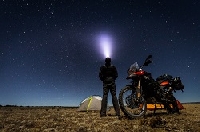
Take the essentials on your motorcycle camping trip
Spinning through wide open roads in the great outdoors makes you yearn for the next motorcycle trip. But packing for it doesn’t. Still, the last thing you want to find out–hundreds of miles from home-is that your tent isn’t big enough or you remembered to bring coffee but not a pot to brew it in.
Pack what you need for a motorcycle camping trip by checking out this list of essentials.
Luggage
Travel bags must be durable, easy to mount, and large enough to comfortably contain your clothing and other supplies. Motorcycle luggage ranges in size from 9-inch duffle bags weighing just over 1 lb. to ultra tour bags with expandable side compartments.
Before deciding which type of motorcycle travel luggage suits you best, consider the main types and their characteristics:
- Hard luggage is made of fiberglass, plastic or aluminum. It is easy to mount to your bike and stays in place. Some sets are quickly detachable. The main advantage of hard luggage is that it locks, although models with built-in locks can be expensive.
- Soft luggage sets consist mostly of duffle bags made of vinyl with compression straps, tie-down straps, and carry hands. These have strong seam construction.
- Leather luggage is favored because it is durable and attractive. You can often sling it over the rear fender and strap it to the bike’s frame. If you decide on leather, make sure to buy saddle soap to keep it looking new.
- Textile luggage is popular because it’s durable, waterproof, and affordable. It’s also easy to mount and remove as most types are made of Velcro and have adjustable straps.
~
Sleeping Gear
Camping allows you to leave behind the stale inside air–and also the comfort of your warm bed. The right sleeping gear can have you refreshed for those long daytime rides.
Here are some suggestions:
- Backpacking bags, also known as “mummy bags,” are narrower at the shoulders and hips. They’re preferred by campers who want that tucked-in fit and extra warmth as they sleep. These bags tend to be lightweight and come filled with duck or goose down, both more comfortable–and more expensive–then polyester or other synthetic fillers.
- Car camping bags have more room. They come in rectangular or barrel shapes and in different sizes to suit large or small body frames. There’s plenty of room for your feet, but the trade-off for all that room is less warmth. These aren’t the best choices if you’ll be sleeping on cold winter nights. But there is one benefit: some styles open up flat, so they can double as blankets.
- Synthetic-filled bags are strong and less costly. Most are made of polyester, which dries quickly if it gets wet, maintains its shape, and is non-allergenic.
- Goose-down is a pure material that provides great insulation (as long as it’s kept dry) and packs down smaller than bags with synthetic fill. But these benefits will cost you more.
Before buying a sleeping bag, check the labels for temperature ratings. Most sleeping bags are rated between 15 and 50 degrees Farenheit. If you’re traveling to a destination with warm temperatures, you’ll need a rating of 35 degrees Farenheit and higher. For colder temperatures, look for bags categorized at 10 degrees Farenheit and lower.
Tents
A tent shields you from weather and wildlife–as long as you buy the right size. How do you know if a tent is big enough? The rule of thumb is this: add one “person” to the tent’s advertised size. So, if a tent boasts enough room for 4 people, picture how it would look holding 5 people in addition to all your other items.
Camping tents come in more styles than you can count. But they tend to fall into three main types:
- Family tents are dome-shaped and big enough for up to six adults and their belongings. Those made of rip-stop nylon won’t tear easily and have waterproof coatings made of polyester and polyurethane. Since family tents are secured to the ground by metal stakes, you should pack a hammer or similar tool to drive the stakes into the ground. These tents usually have about 90 square feet of floor space and stand over six feet high. Before purchasing one, take time to read the assembly instructions. Otherwise, you could be finding out it’s too difficult to put together as you’re in the midst of a thunderstorm. A family tent with a “rain fly” will let you leave shoes just outside the tent door and will keep them dry.
- Backpacker tents are the lightest in weight, usually under three pounds, and will take up only about 15″ x 7″ when packed. They are intended for no more than 3 people. The better brands consist of freestanding aluminum frames that are easy to set up and have a breathable mesh that protects you from bugs while offering ventilation. Look for styles that come with storage pockets where you can stash smaller items.
Cooking Gear
As you plan what you need for a motorcycle camping trip, don’t forget to add food to your list. Your best bet for camp-side cooking supplies is to invest in a utensil set.
Utensil sets most often contain polypropylene plates, bowls, insulated mugs, lids, pots, and non-stick fry pans — basically, all you need to prepare home-cooked meals on the road. The utensils–knives, forks, spoons, and spatulas–are made of steel, which which means they won’t bend during transport. The entire set, dishes and all, wraps up like a blanket into a neat package with handles and adjustable straps.
These items might not be enough for you to create a home away from home. But they’re a good start and will help ensure your next motorcycle camping trip is safe and fun.
